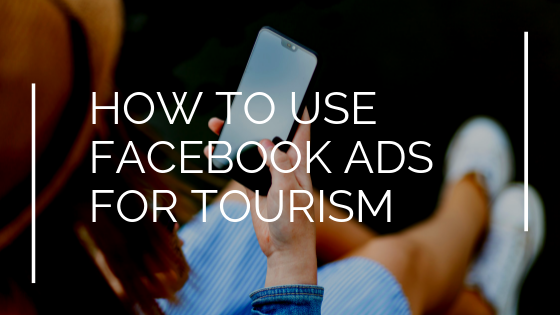How to use Facebook Ads for Tourism
Facebook advertising is one of the most affordable digital ad channels around. It’s also where a majority of people are spending their time. With 2.4 billion monthly active users, over a third of the total world population, Facebook remains one of the best channels for reaching people with messages. What does that mean for those of us working in the tourism industry? It means that a big chunk of your target audience uses Facebook. Whether you’re putting the ads together yourself, or working with an agency (like us!), these recommendations can help you assess your strategy when using Facebook ads for tourism purposes.

Optimization Strategy
Facebook offers several optimizations to choose from when running a campaign. Optimizations mean that the platform will serve the ads to the people most likely to take a certain action. So for example, if you are running a campaign that’s optimized for post engagement, Facebook will show the post to people who react to, comment and share posts.
While there are many optimization choices, for our DMO and attraction clients we focus on a top few. Keeping the goal of the promotion in mind makes selecting the right mix of optimizations easier.
- Link clicks. Drive traffic to your website page for what you’re promoting.
- Reach. This will reach the most people for your budget.
- Post engagement. Increase interactions on your post with this kind of ad.
- Event responses. Putting budget here means reaching people interested in events. And those people are your target audience. This also gives you the ability to post in the event and they’ll receive the notifications – so they’re getting more information even if they don’t like the page (yet).
- Page likes. This recently became more important to run, since the “like page” button was taken off of other kinds of ads in 2019.
Target Audience
Most destinations we work with have a solid idea of who they want to target for their promotions. It’s typically a drive-to market, so a geographic area reaching people within a 2-6 hour drive, depending on the promotion. Demographics vary based on the promotion. In tourism, women are typically the decision-makers but that isn’t always the case. We run Facebook ads for tourism around Genesee County’s golf packages program every year, and men are most likely to engage with those ads.
If you have a customer list, or leads list, you can use those to target specific individuals or to build a lookalike audience. A lookalike audience is when Facebook looks at your list, finds commonalities, then extrapolates those traits to find other users who relate to your original list. If you don’t have a list, interest-based targeting also works for tourism promotions. With the iOS 14 changes that took place earlier this year, lookalike targeting may not outperform interest-based targeting.
Measurement
Facebook automatically tracks many data points for the ads running on the platform. Measurement starts when you start building the campaign strategy. Know your Key Performance Indicators (KPIs) related to the goals of the campaign when choosing the optimizations. If you really want link clicks, then I wouldn’t recommend only running post engagement ads. Your click results will be lower than if the ads were run with the link click optimization.
Another measurement component to keep in mind is the Facebook pixel. This requires a few more steps during setup, but can go beyond what happens on Facebook, and measure activity on your website as a result of the ads. This could be a form that people fill out, a button they click, or even a purchase they make.
Creative
The creative on Facebook ads is different from other digital ads. It’s all about the platform, so ads look like Facebook posts. There are no banner ads here and actually, highly designed images don’t do well. While Facebook did get rid of its 20% text rule earlier this year, people respond better to ads that look like native posts.
So what is in the creative? An image or visual, text in the “post,” a headline and a link. Those are the basic, main elements that you’ll see. Call to action (CTA) buttons are also a great element to add depending on optimization, and there are a selection of pre-written buttons to choose from. When making Facebook ads for tourism promotions, I recommend keeping the call to action clear in the text, supporting that with the CTA button, and using an eye-catching image or set of images.
If you’re not sure which way to go with the creative, testing can help determine between a variation on one element. If you want to test multiple variables at once, use dynamic creative, which can be used for some, not all, optimizations. I like using dynamic creative to see which combination of ad elements works best, while also testing different versions.
Want to dig in deeper? Download our ebook about getting started with Facebook advertising.
Author
Related Posts
What the heck is a Facebook Pixel?
You’ve probably heard of pixels, you may have even heard of Facebook pixels. But what is it, really? A Facebook pixel measures online activities from…
